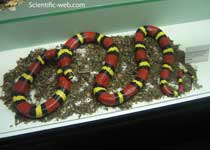The milk snake (Lampropeltis triangulum; French: Couleuvre tachetée; Spanish: Culebra-real coralillo)[1] is a species of king snake. There are 25 subspecies among the milk snakes, including the commonly named scarlet kingsnake (L. t. elapsoides).[1] The subspecies have strikingly different appearance, and many of them have their own common names. Some authorities suggest that this species may be split into several separate species.[1] They are distributed from southeastern Canada, through most of the continental United States, to Central America, down to western Ecuador and northern Venezuela of northern South America.[1][2] They grow 20 to 60 inches (50-152 cm) long.[1] Appearance Milksnakes have smooth and shiny scales and their typical color pattern is alternating bands of red-black-yellow or white-black-red.[1] However, red blotches instead of bands are seen in some populations.[1] Some milk snakes have a striking resemblance to coral snakes and this mimicry (known as Batesian mimicry) likely scares away potential predators. While both milksnakes and coral snakes possess transverse bands of red, black and yellow, a common mnemonic can be used to properly distinguish between the deadly coral snake and the harmless milksnake: * "Red touches yellow, you're a dead fellow. Red touches black, you're okay, Jack." or;
Snakes have no eyelids and instead have a transparent covering that rests over their eyes called brilles to protect their eyes from dust and dirt.[3] The brilles give them a "glassy-eyed" blank appearance.[3] Habitat Across the wide range of this species, habitat varies. Typically, milksnakes live in forested regions, however, in some regions they can be located in open prairies. In various parts of across its distribution, milksnakes often abide in rocky slopes.[1] Behavior Milksnakes activity is mostly nocturnal. They are primarily terrestrial, except the scarlet kingsnake which is known to take shelter under the bark of standing dead trees.Milk snakes eat a lot of different rodents. Diet Young milksnakes typically eat slugs, insects, and earthworms.[3] Adult diet frequently includes lizards (especially skinks), and small mammals.[1] They are also known to eat birds and their eggs, frogs, fish, and other snakes.[3] Milk Snakes are much more opportunistic eaters than the fox snake or corn snake. They have been known to consume a variety of animals including rodents, eggs, birds, reptiles, amphibians, and invertebrates. Nevertheless the diet of an adult milk snake still primarily consists of rodents. They are nocturnal eaters and are often found during the day in old barns and under wood. Like other members of the king snake family, the milk snakes sometimes eat other snakes, and do have at least some immunity to their venom. An early myth about milksnakes is that they suck cow udders to get the milk.[1] The myth is entirely false.[1] The milksnake does not have the physical capabilities to suck milk out of a cow. Milksnakes are, however, frequently found in and around barns,[1] making use of their cool and dark environments, and for the easily accessed populations of rodents[1] to feed on. This proximity to barns, and therefore cows, probably gave rise to the myth.[1] Reproduction Milksnakes are oviparous, laying an average of about 10 eggs per clutch, although that number may vary by region.[1] The milk snake mates from early May[3] to late June. In June and July, the female lays three to twenty-four eggs beneath logs, boards, rocks, logs and rotting vegetation.[3] The eggs incubate for approximately two months, and hatch around August or September.[3] Milksnakes typically live around twelve years.[3] Conservation status The milksnake is not listed by the IUCN, but in some areas, there may face significant pressure due to pet trade collection.[1] Because this species' high value in the pet trade, many subspecies are now being bred in captivity for sale.[1] Subspecies * Guatemalan Milksnake, L. t. abnorma (Bocourt, 1886) References
External links Retrieved from "http://en.wikipedia.org/" |
|

